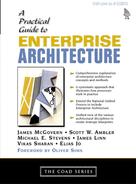Chapter 1. Systems Architecture
The first requisite for success is the ability to apply your physical and mental energies to one problem incessantly without growing weary.
—Thomas Edison (1847–1931)
Systems architecture can best be thought of as both a process and a discipline to produce efficient and effective information systems.
It is a process because a set of steps is followed to produce or change the architecture of a system.
It is a discipline because a body of knowledge informs people as to the most effective way to design.
A system is an interconnected set of machines, applications, and network resources. Systems architecture unifies that set by imposing structure on the system. More importantly, this structure aligns the functionality of the system with the goals of the business.
Systems architecture encompasses the infrastructural layer of Figure 1-1.
Figure 1-1. Enterprise architecture model.

The basic purpose of systems architecture is to support the higher layers of the enterprise architecture. In many companies, the software and hardware represent a significant portion of the enterprise's total assets. It is important that enterprise architects do not equate their duties with the objects, the applications, or the machines that comprise their domain. The fundamental purpose is to support and further the business objectives of the enterprise. Hardware and software objects are fundamentally transient and exist only to further the purposes of the business.
Systems architecture is also used as part of the process of keeping the enterprise architecture aligned with the business goals and processes of the organization. It is important to understand the technical details of the infrastructure and the applications running within it but also to have the knowledge to participate in the process of architectural change with the enterprise architectural team. That involves the following:
Defining the structure, relationships, views, assumptions, and rationales for the existing systems architecture and the changes in relationships, views, assumptions, and rationales that are involved in any changes required for moving from what is to what is desired.
Creation of models, guides, templates, and design standards for in use in developing the systems architecture.
